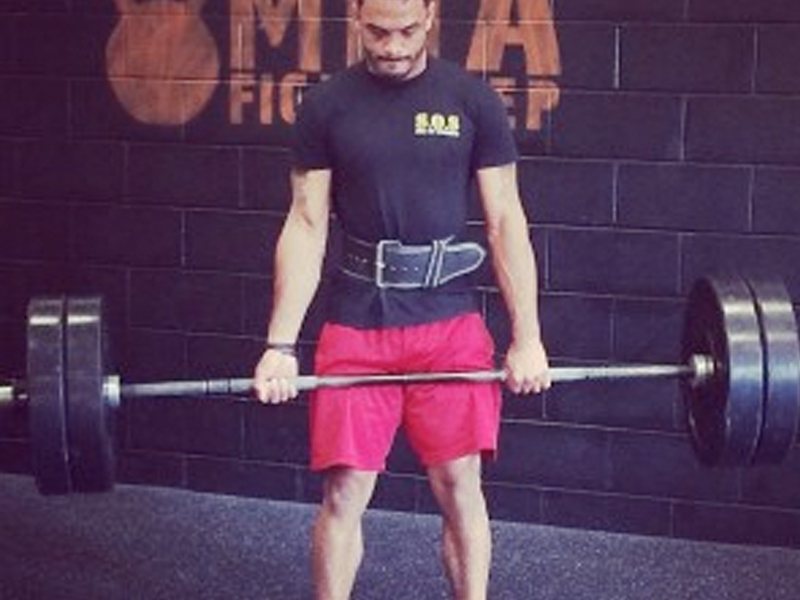What qualities are you trying to improve?
Do you have smart progressions in your programs?
What about de-loads?
In my humble opinion, you should have a sound logical reason for everything you do. Remember, success leaves clues and it’s not necessary to re-invent the strength and conditioning wheel. If you read a few books, pay attention and constantly learn, you can do a pretty damn good job of preparing a fighter to step in the cage.
Today we are going to look at how to develop strength and strategies to keep you from plateauing.
1. Keep it Under 5 Reps
 You don’t always need to keep it under 5 reps, but if your goal is raw strength, then keeping it under 5 reps is a smart idea. When people like Pavel Tsatsouline, Mark Rippetoe, Kirk Karwoski, and Andy Bolton tell say you should keep the reps under 5 for strength, I am gonna listen.
You don’t always need to keep it under 5 reps, but if your goal is raw strength, then keeping it under 5 reps is a smart idea. When people like Pavel Tsatsouline, Mark Rippetoe, Kirk Karwoski, and Andy Bolton tell say you should keep the reps under 5 for strength, I am gonna listen.
The 5×5 rep scheme is incredibly popular (with good reason) and the link below includes some excerpts from Dan John and his thoughts on 5×5 variations.
2. Be Patient and Rest
This can be tough for people with exercise ADD.
Athlete – “Coach- what do I do after this set of heavy squats?”
Me – “Rest 3-5 minutes and do it again.”
There are several reasons why resting 3-5 minutes in between sets is a good idea. Here are a few:
- Creatine phosphate recovery can take anywhere from 3 to 5+ minutes. When training heavy, we need near maximal muscle contraction and higher levels of creatine phosphate are ideal for this. If you have ever lifted heavy, you won’t argue with me on this.
- Safety. If you are going to lift heavy, you don’t want to perform the lift in a fatigued state. Resting 3-5 minutes should give you the rest needed to perform multiple sets with safe and proper technique. So wait, Mike! Are you telling me that I can get strong and not jack up my back every 3 months? Yup, unless you enjoy getting hurt. If that’s the case, keep doing what you’re doing.
3. De-load
A de-load can be programmed in several ways, but here is my favorite way to program a de-load week.
Let’s say that you are on a 10 -week strength cycle using 3% jumps each week. Weeks 1-5 call for a 5×5 rep scheme, and week 6 moves to a 3×3 rep scheme. That, my friends, is a built in de-load! You have been performing 5×5 for 5 weeks and the sets and reps are getting pretty damn hard, but you are hitting them. When you switch from 5×5 to 3×3 with the same 3% jump, you will be a happy person. The drop in reps should seem “easier,” but you are still increasing the weight lifted. Kind of awesome, huh?
4. Proper Warm Up Sets
Let’s say you are towards the end of your program and the workout calls for 2×2 with 405lb on the deadlift. A few warm up sets are ideal to move that weight “comfortably.” It’s not a good idea to start with 135 for 5 then move right to 405lb!
Here is an example of how to ramp up to a 405lb deadlift for 2×2!
- 225 x2
- 275 x2
- 315 x2
- 355 x2
- 405 x2
- 405 x2
5. Treat Light Weight Heavy, So Heavy Weight Feels Light
If you’ve ever started a new program, the first couple weeks seem fairly light. It’s easy to disregard warm up sets and sometimes even the working sets. This is a bad idea! It’s like sneezing when you pee, bad things happen!
 Approach the bar like it’s your 1RM! Respect the weight and treat it like it’s 5 times the amount! Practice makes perfect too. If you approach every set and rep with focus, intensity and discipline, this will carry over when it’s time to go heavy. This is a skill that takes time, but I can pretty much guarantee you won’t miss as many lifts when its time to pull a 1RM or 2RM.
Approach the bar like it’s your 1RM! Respect the weight and treat it like it’s 5 times the amount! Practice makes perfect too. If you approach every set and rep with focus, intensity and discipline, this will carry over when it’s time to go heavy. This is a skill that takes time, but I can pretty much guarantee you won’t miss as many lifts when its time to pull a 1RM or 2RM.
StrongFirst deadlift team captain, Jason Marshall, can pull over 600lbs at 181lb bodyweight. I have seen him approach the bar loaded with 135lb and make it look like 600lb. Obviously, 135lb is easy for him, but he approaches it the same, a mark of a true professional.
Remember, strength is a skill and it doesn’t happen overnight. Spend a solid year with a good coach and he can do wonders for your strength and fight game.
As always, train smart, train hard!!!

